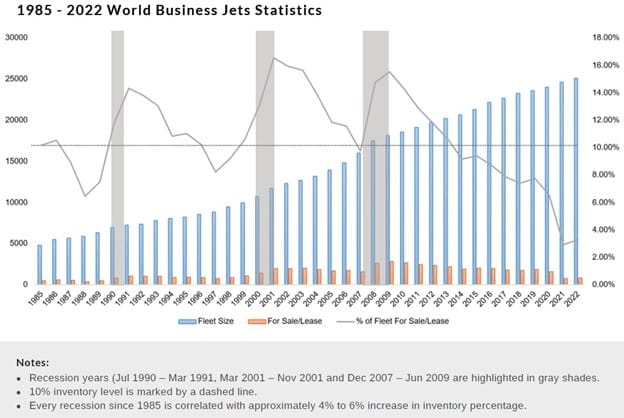Michael Barber, RVP, Insights Into The Business Jet Market

Business Jet Market Insights by Michael Barber: “Looking Back and Moving Forward in the Business Jet Market: A Stabilizing New Normal with Continued Demand and Low Inventory Levels.”
In sitting down with Michael Barber to discuss the current business aviation market, his passion for this industry in undeniable. Michael discusses the markets from both a historical and a future-focused standpoint, making his thoughts both informative and optimistic.
Since speaking with Flying in Q4, do you see any differences as we are Approaching Q2 of 2023?
“While on BusinessAir TV, I discussed rising inventory levels for several aircraft models. Since then, we are seeing fleetwide inventory levels increase week to week. The effect is a stabilization in valuations. The massive Original Equipment Manufacturers (OEMs) backlogs paired with continued demand suggests that the stabilization we are witnessing is a new normal with no expectation of a major fall out in value.”
Insights Into the Past
How does the current market compare to the major historical economic events of the last 40 years?
“According to Amstat, since late 1985, the number of worldwide active business jets has increased significantly. The fleet size rose from 4,801 units to 25,113 units, as of Q4 2022. While the rate of growth varies year-to-year, the overall trend indicates a substantial increase. Surprisingly, even during economic downturns like the early 90s, early 2000s, and the 2008 financial crisis, the business jet fleet continued to grow, despite low prices and high percentages of the fleet being for sale.”
Michael further states, “Beginning in late 2009, there has been a consistent decrease in the listed preowned business jet inventory. In the US, this reached an unprecedented rock-bottom level of approximately 2.5% at the end of the COVID-19 pandemic. Given the deep backlog of the aerospace supply chain, it is likely to take several years to replenish the inventory.”

Insight into Circumstances Affecting the Current Market
How are first-time buyers and OEM deliveries affecting the preowned market?
“The current “seller’s market” is further fueled by a growing number of first-time jet owners. This group represents approximately one third of the current buyers. As Wayne Starling, Executive Director at the International Aircraft Dealers Association, recently noted in the Fourth Quarter IADA Market Report, “The trend toward first-time buyers over the past two years continues, particularly in the midsize to large cabin aircraft. We believe these buyers will stay in the market for the long haul as the benefits of private ownership become more and more evident.””
“Currently, OEMs are reporting delivery slots as far out as 2026. The backlogs are matched with significant increases in base prices and reduced discounts. These pricing changes make sense as the OEMs have watched the pre-owned market values climb during the last 18 months. Taking advantage of the pre-owned market demand, numerous new aircraft owners have turned into sellers overnight by selling their newly delivered asset for substantial profits. This is a direct result of extremely high demand and minute supply, and it has not gone away.”
An Insight Into The Future
What should we expect to see in the next 3 quarters of 2023?
“It is uncertain where the market will go from here. With the continued increase in demand and inventory levels well below the historical 10% mark, the seller’s market is likely to continue for the foreseeable future.”
In conclusion, if you would like a copy of our current Business Jet Market Overview, including additional data and graphs of the percentage of fleet for sale related to the Historical Average Fund Rate and to the S&P 500 Average Closing Prices, reach out to Leviate’s Market Intel Team!

